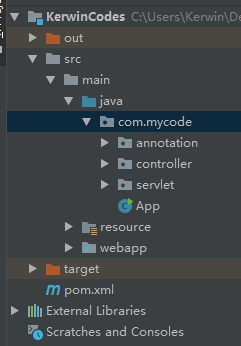手写简易SpringMVC
手写系列框架代码基于普通Maven构建,因此在手写SpringMVC的过程中,需要手动的集成Tomcat容器
必备知识:
Servlet相关理解和使用,Maven,Java 反射,Java自定义注解
配置Web类型结构
结构如图所示:

注意 要设置 webapp为web moudle -> IDEA 有蓝色小圈圈为准,resource 配置为资源文件
配置Web.xml,配置Artifacts,配置文件


<?xml version="1.0" encoding="UTF-8"?>
<web-app xmlns:xsi="http://www.w3.org/2001/XMLSchema-instance"
xmlns="http://java.sun.com/xml/ns/javaee" xmlns:web="http://java.sun.com/xml/ns/javaee/web-app_2_5.xsd"
xsi:schemaLocation="http://java.sun.com/xml/ns/javaee http://java.sun.com/xml/ns/javaee/web-app_3_0.xsd"
version="3.0">
<servlet>
<servlet-name>KerwinCodes</servlet-name>
<servlet-class>com.mycode.servlet.MyDispatcherServlet</servlet-class>
<init-param>
<param-name>contextConfigLocation</param-name>
<param-value>application.properties</param-value>
</init-param>
<load-on-startup>1</load-on-startup>
</servlet>
<servlet-mapping>
<servlet-name>KerwinCodes</servlet-name>
<url-pattern>/*</url-pattern>
</servlet-mapping>
</web-app>
// 配置包扫描的路径
scanPackage=com.mycode
编码阶段
- 第一步毋庸置疑,我们需要创建必要的注解,如MyController,MyRequestMapping等等
@Target(ElementType.TYPE)
@Retention(RetentionPolicy.RUNTIME)
@Documented
public @interface MyController {
String value() default "";
}
@Target({ElementType.TYPE,ElementType.METHOD})
@Retention(RetentionPolicy.RUNTIME)
@Documented
public @interface MyRequestMapping {
String value() default "";
}
@Target(ElementType.PARAMETER)
@Retention(RetentionPolicy.RUNTIME)
@Documented
public @interface MyRequestParam {
String value();
}
- 需要思考我们如何才能实现SpringMVC
A.参考真正的SpringMVC, 它是基于Spring的基础上,因此我们需要自行实现IOC容器
B.想要实现IOC容易,管理Bean,我们就需要根据包扫描的路径进行全项目扫描
C.全项目扫描后,利用反射,同时根据注解判断是否是Bean,然后注入到Map容器中即可
D.遍历容器,获取存储的Bean中的方法,配合RequestMapping注解,得到 url - method映射,同时得到 url - object映射,存储到新的Map集合总,便于后续反射调用
E.页面请求时候,判断request.url 映射的到底是哪一个bean,哪一个方法 同时获取方法的参数,解析request的参数,即可匹配路径调用方法
F.万事俱备,到底如何运行?
Servlet -> init方法,doGet方法,doPost方法 实质就是Servlet生命周期中初始化和真正执行策略的方法,我们只需要重写方法,然后让doGet,doPost 都调用我们的方法即可
- 核心代码如下:
package com.mycode.servlet;
import com.mycode.annotation.MyController;
import com.mycode.annotation.MyRequestMapping;
import javax.servlet.ServletConfig;
import javax.servlet.ServletException;
import javax.servlet.http.HttpServlet;
import javax.servlet.http.HttpServletRequest;
import javax.servlet.http.HttpServletResponse;
import java.io.*;
import java.lang.reflect.Member;
import java.lang.reflect.Method;
import java.net.URL;
import java.util.*;
/**
* ******************************
* author: 柯贤铭
* createTime: 2019/9/5 11:53
* description: MyDispatcherServlet
* version: V1.0
* ******************************
*/
public class MyDispatcherServlet extends HttpServlet{
/** 配置信息 **/
private Properties properties = new Properties();
/** 所有类的Class地址 **/
private List<String> classNames = new ArrayList<>();
/** Bean容器 **/
private Map<String, Object> iocFactory = new HashMap<>();
/** HandlerMapping - 方法**/
private Map<String, Method> handleMapping = new HashMap<>();
/** HandlerMapping - 对象**/
private Map<String, Object> controllers = new HashMap<>();
@Override
public void init(ServletConfig config) throws ServletException {
// 1.加载配置文件
doLoadConfig(config.getInitParameter("contextConfigLocation"));
// 2.初始化所有相关联的类,扫描用户设定的包下面所有的类
doScanner(properties.getProperty("scanPackage"));
// 3.拿到扫描到的类,通过反射机制,实例化,并且放到ioc容器中(k-v beanName-bean)
doInstance();
// 4.初始化HandlerMapping(将url和method对应上)
initHandlerMapping();
}
@Override
protected void doGet(HttpServletRequest req, HttpServletResponse resp) throws ServletException, IOException {
this.doPost(req,resp);
}
@Override
protected void doPost(HttpServletRequest req, HttpServletResponse resp) throws ServletException, IOException {
try {
doDispatch(req, resp);
} catch (Exception e) {
e.printStackTrace();
}
}
// 加载配置文件索取包扫描路径
private void doLoadConfig (String fileUrl) {
try {
properties.load(this.getClass().getClassLoader().getResourceAsStream(fileUrl));
} catch (IOException e) {
e.printStackTrace();
}
}
// 扫描目录下所有的类
private void doScanner (String rootPath) throws ServletException {
URL url = this.getClass().getClassLoader().getResource( "/" + rootPath.replaceAll("\.", "/"));
File file = new File(Objects.requireNonNull(url).getFile());
if (!file.isDirectory()) {
throw new ServletException("Base Package is wrong.");
}
for (File current : Objects.requireNonNull(file.listFiles())) {
if (current.isDirectory()) {
doScanner(rootPath + "." + current.getName());
} else {
String className = rootPath + "." + current.getName().replace(".class", "");
classNames.add(className);
}
}
}
// 拿到所有的classNames 通过反射创建其对象 - 放入ioc容器中
private void doInstance () {
if (classNames.isEmpty()) {
return;
}
try {
for (String className : classNames) {
Class<?> clazz = Class.forName(className);
if (clazz.isAnnotationPresent(MyController.class)) {
iocFactory.put(clazz.getSimpleName(), clazz.newInstance());
}
}
} catch (Exception e) {
e.printStackTrace();
}
}
// 初始化HandlerMapping(将url和method对应上)
private void initHandlerMapping () {
if (iocFactory.isEmpty()) {
return;
}
for (String key : iocFactory.keySet()) {
Class<? extends Object> clazz = iocFactory.get(key).getClass();
if (!clazz.isAnnotationPresent(MyController.class)) {
continue;
}
// 类 url
MyRequestMapping annotation = clazz.getAnnotation(MyRequestMapping.class);
String baseUrl = annotation.value();
Method[] methods = clazz.getMethods();
for (Method method : methods) {
if (method.isAnnotationPresent(MyRequestMapping.class)) {
String mappingUrl = method.getAnnotation(MyRequestMapping.class).value();
// 获取匹配方法及对象 方便之后通过反射调用
handleMapping.put(baseUrl + mappingUrl, method);
controllers.put(baseUrl + mappingUrl, iocFactory.get(key));
}
}
}
}
// 中央处理器
private void doDispatch(HttpServletRequest request, HttpServletResponse response) throws Exception {
if (iocFactory.isEmpty() || handleMapping.isEmpty() || controllers.isEmpty()) {
return;
}
String url = request.getRequestURI();
// 如果不存在url
if (!handleMapping.containsKey(url)) {
response.getWriter().write("Do Not Get Url : 404 ERROR");
return;
}
// HandleMapping 的方法
Method method = handleMapping.get(url);
// 获取方法的参数列表
Class<?>[] parameterTypes = method.getParameterTypes();
//获取请求的参数
Map<String, String[]> parameterMap = request.getParameterMap();
//保存参数值
Object [] paramValues= new Object[parameterTypes.length];
// 方法的参数列表
for (int i = 0; i< parameterTypes.length; i++){
//根据参数名称,做某些处理
String requestParam = parameterTypes[i].getSimpleName();
if (requestParam.equals("HttpServletRequest")){
//参数类型已明确,这边强转类型
paramValues[i] = request;
continue;
}
if (requestParam.equals("HttpServletResponse")){
paramValues[i] = response;
continue;
}
if(requestParam.equals("String")){
for (Map.Entry<String, String[]> param : parameterMap.entrySet()) {
String value = Arrays.toString(param.getValue()).replaceAll("\[|\]", "").replaceAll(",\s", ",");
paramValues[i] = value;
}
}
}
method.invoke(controllers.get(url), paramValues);
}
}
- 测试代码:
@MyController
@MyRequestMapping("/test")
public class TestController {
@MyRequestMapping("/doTest")
public void test1 ( HttpServletRequest request, HttpServletResponse response,
@MyRequestParam("param") String param){
System.out.println(param);
try {
response.getWriter().write( "doTest method success! param:"+param);
} catch (IOException e) {
e.printStackTrace();
}
}
@MyRequestMapping("/doTest2")
public void test2(HttpServletRequest request, HttpServletResponse response){
try {
response.getWriter().println("doTest2 method success!");
} catch (IOException e) {
e.printStackTrace();
}
}
}
测试结果:
http://localhost:8080/ -> Do Not Get Url : 404 ERROR
http://localhost:8080/test/doTest2 -> doTest2 method success!
http://localhost:8080/test/doTest?param=asdasdad -> doTest method success! param:asdasdad
源码地址:https://github.com/kkzhilu/KerwinCodes code_springmvc分支